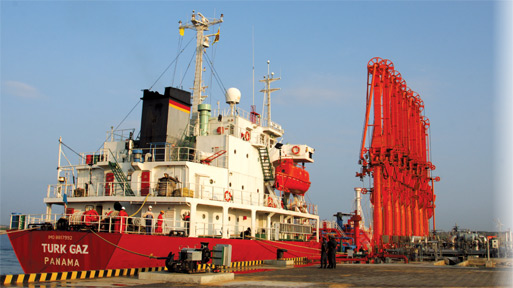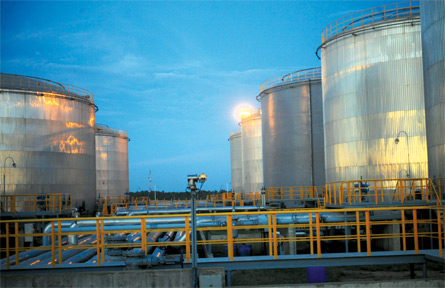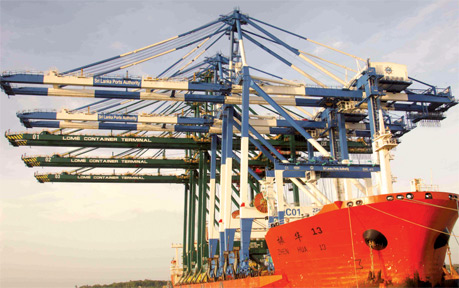Huge potential for bunkering at Hambantota Port
By Gamini Warushamana
The Sri Lanka Ports Authority (SLPA) will commission bunkering today
at Magam Ruhunupura Mahinda Rajapaksa Port (MRMRP).
 The Hambantota port will now earn revenue from one of the main
business channels that the port was expected to earn in the planning
stages of the port. The Hambantota port was designed to cater to the
hundreds of ships that sail every day in the main East-West shipping
route in the Indian ocean. The Hambantota port will now earn revenue from one of the main
business channels that the port was expected to earn in the planning
stages of the port. The Hambantota port was designed to cater to the
hundreds of ships that sail every day in the main East-West shipping
route in the Indian ocean.
The advantage of this geographical location was the main reason for
building the port in Hambantota. The tank farm owned by SLPA consists of
14 tanks and eight of them are used by the SLPA for bunkering.
Three tanks have been leased out to the Ceylon Petroleum Corporation
(CPA) for aviation fuel to be supplied to the Mattala International
Airport and the other three tanks have been leased out to Litro Gas
company for LP gas storage and they have been already commissioned.
The total bunker capacity is 51,000 cubic metres and the capacity for
aviation fuel and LP gas are 23,000 and 6,000 cubic metres, said
Hambantota Port Chief Engineer Agil Hewageegana.
The SLPA has invested $ 76 million in the tank farm and bunkering
infrastructure that includes offshore bunkering facilities. The project
was financed by a $ 65 million loan from China EXIM bank and remaining
by the SLPA.
Hewageegana said that the potential in the bunkering business in
Hambantota is huge and the SLPA hopes to carry out business promotions.
According to estimates, over 200 ships pass Hambantota every day on the
main shipping line, 12 km away from the Hambantota port.
“If we can cater to three ships per day we will break even and ships
need not come into the harbour as we have offshore bunkering
facilities,” Hewageegana said.
Until 2002, the bunkering business was a state-owned monopoly through
the CPC and in 2002, the sector was liberalised and private players came
in.
Today, there are around six private companies in the business and
most of them provide services around the Colombo port. The SLPA is the
first bunkering operator to start business in the South.
Industry experts said that this move is good for the country and the
industry, if the new player can attract new business.
“The new player should increase the size of the pie and not share the
existing one. Since the SLPA is targeting the main South West shipping
route from the southern part of the country, there is potential to
attract new businesses,” an expert who preferred to remain anonymous
said.
According to experts since the bunkering business is competitive
everything will depend on the price.
Since the business is becoming more and more competitive with new
players coming in, there will be downward pressure on prices resulting
in a narrow profit margin.
There are three main bunkers, Fuel oil 180 CST, 380 CST and marine
gas oil. The prices of these three bunkers will be the main factor that
the business prospect will depend on and our biggest competitor in the
South Asian region is India.
India offers bunkering at a competitive price. Singapore offers the
lowest bunker price in the Asian region while Rotterdam offers the
world's lowest price, industry experts said.
|

Tank farm and bunkering facility |
Consultant to the bunkering project of the SLPA, Captain Channa
Abeygunawardena said that the SLPA can face this challenge and offer
bunkering at most competitive prices.
“We can service at the most competitive rates among other local
players because we have a dedicated bunkering facility with all the
modern infrastructure. We will import bigger quantities and, therefore,
the trade cost is less,” he said.
“In the case of Indian competitors, although their price is low their
services are a long distance from shipping routes. So we have the
advantage of our geographical location and, therefore, India will not be
a challenge,” Abeygunawardena said.
He said that in addition to the main bunkers, the new SLPA facility
has the capacity to supply blended products.
Another unique feature we have at Hambantota is the state-of-the-art
reception facility for slops and waste oil from vessels.
Only a few ports in the region have this facility. The waste oil
reception plant has a storage capacity of 500 cu metres and will enable
the vessels passing Sri Lanka to discharge their oily waste while
complying with MARPOL regulations and ensuring clean and green
environment.
All these are very significant advantages we have to face the
competition, he said.
The bunkering business faces another challenge as a result of
development in the ship-building industry, energy efficient bigger
vessels are coming in, therefore, the consumption of bunker facilities
is much less compared to the earlier generation of ships.
Over the past few years the use of bunkers has not grown
significantly. The shipping industry is also going through a bad period
mainly due to the global economic crisis and its slow recovery.
As a result shipping lines are compelled to cut costs and the main
cost component of operating a ship is the bunker cost which accounts for
40-50 percent of the total cost. Ships are adopting slow steaming and
therefore, bunker use is declining.
|

New ZPMC Ship to Shore (STS) Gantry Cranes and one Rubber Tyred
Gantry (RTG) Crane arriving at MRMRP on board MV Zhen Hua 13. |
However, if this new bunkering arm of the MRMRP could begin earning
sufficient revenue, it would stop criticism of one of the largest
infrastructure projects in recent Sri Lanka history.
Due to slow business turnover in the harbour at the beginning, it was
criticised as being a white elephant by opposition political parties.
However, business is gradually increasing and according to officials, 91
vessels called at the harbour from January to May this year compared to
35 ships for the corresponding period last year, a 160 percent increase.
The cargo handled at the port increased by 376 percent from 21,542
tonnes to 102,558 tonnes. After the shifting of motor vehicle imports to
the MRMRP, port operations have improved significantly and from January
to May this year 87 RO-RO vessels called at the harbour compared to 35
such vessels for the corresponding period last year.
This year MRMRP has handled 14,019 domestic and 58,593 transshipment
units in RO-RO operations, the officials said.
Infrastructure development of the port is continuing and construction
work on the second phase is now under way. In addition two new ZPMC Ship
to Shore (STS) Gantry Cranes and one Rubber Tyred Gantry (RTG) Crane
arrived from China last week. |

